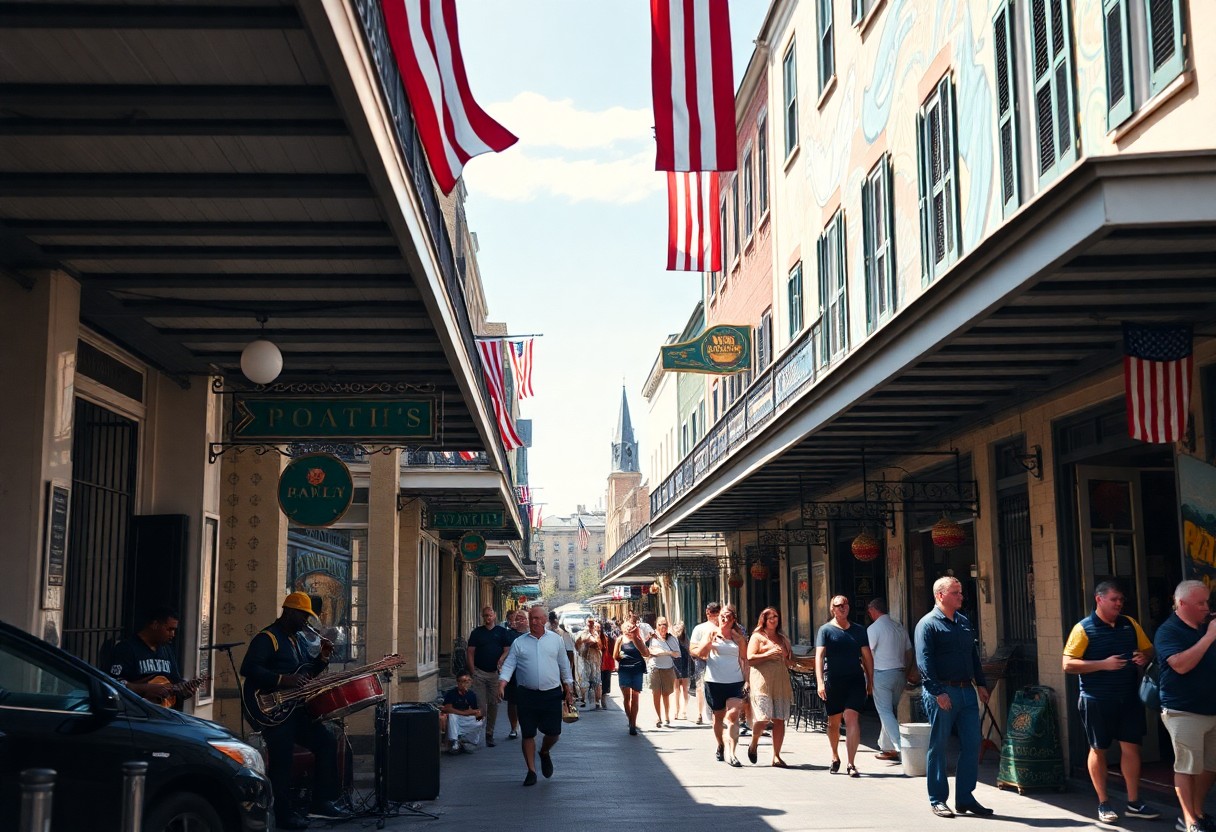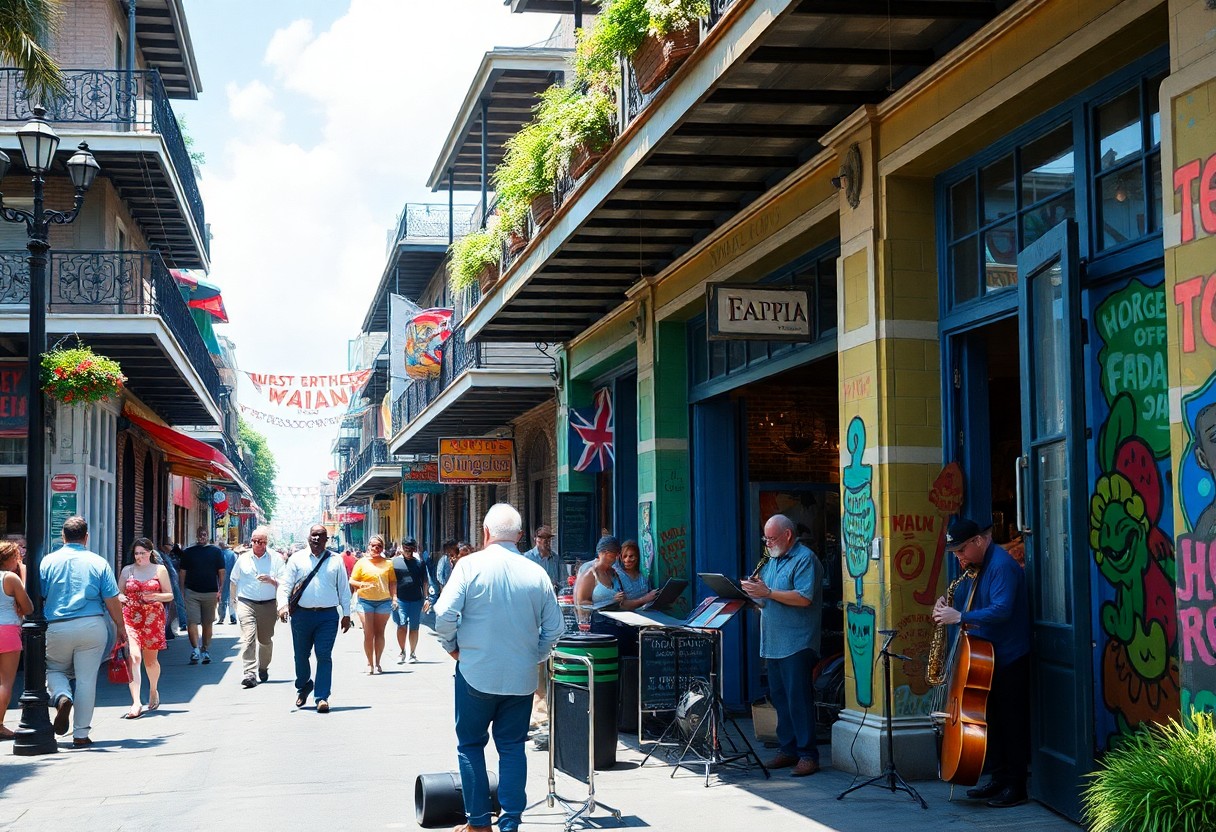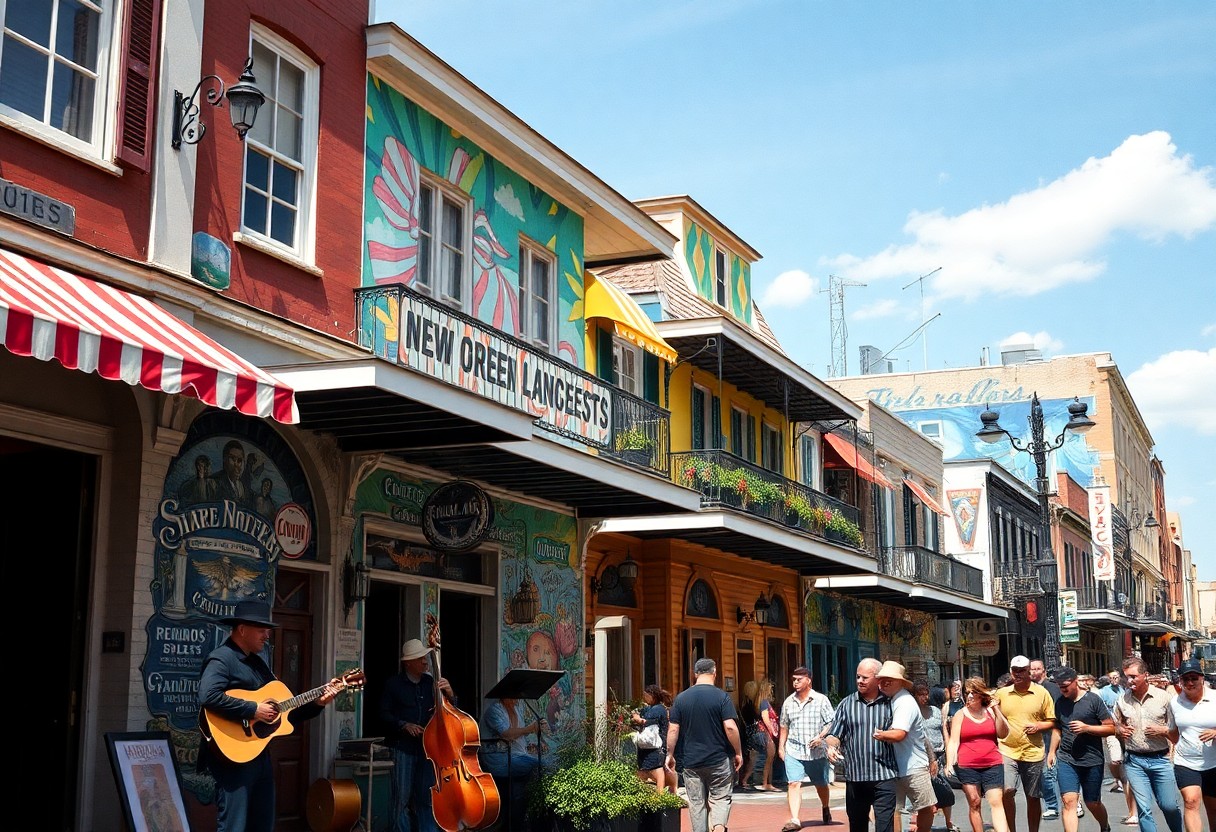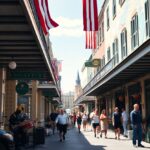
As you frame your shots along Frenchmen Street, let the vibrant music spilling from every open doorway guide your timing and angles while capturing the soul of New Orleans. Focus on the weathered hands of a trumpeter mid-note or the expressive faces of dancers twirling under strings of glowing lights. In the Garden District, old mansions with wrought-iron balconies offer endless texture and history, but capturing the contrasting modern street art reveals the city’s evolving spirit. Early morning shots in City Park showcase serene oak trees draped in Spanish moss, emphasizing New Orleans’ blend of natural beauty and urban grit through your viewfinder.
Key Takeaways:
- New Orleans is known for its lively streets filled with music, art, and cultural festivities that provide a rich backdrop for photography.
- The city’s colorful architecture, including iconic French Quarter buildings, offers unique visual stories that reflect its history and heritage.
- Capturing the essence of New Orleans involves embracing its diverse cultural influences, from jazz and blues to Creole and Cajun traditions.
- Street scenes featuring local musicians, dancers, and vibrant markets highlight the energetic spirit of the city throughout the day and night.
- Exploring different neighborhoods reveals a variety of moods and styles, making New Orleans a dynamic destination for photographers seeking variety and authenticity.
Highlights of New Orleans’ Vibrant Streets and Culture
| Feature/Area | Description & Photographic Appeal | Notable Details/Examples |
|---|---|---|
| French Quarter | Narrow cobblestone streets, centuries-old buildings, intricate ironwork, lively performers, bustling markets. | St. Louis Cathedral, Bourbon Street, gas lamps at dusk, colorful shutters |
| Garden District | Grand mansions, Victorian/Greek Revival architecture, towering oaks with Spanish moss, blooming gardens, historic streetcars. | Wrought iron fences, pastel blooms, tranquil leafy avenues, quaint cafes |
| Street Music Scenes | Energetic street musicians, jazz/blues/brass bands, candid emotion and movement, day and night performances. | Frenchmen Street, impromptu dances, neon signage at night, relaxed daytime sessions |
| Cultural Events | Colorful parades, lively street performances, bustling markets, layers of storytelling and emotion. | Mardi Gras, jazz festivals, vibrant costumes, beadwork, spontaneous dances |
| Mardi Gras | City-wide celebration, kaleidoscope of colors, floats, beads, coins, masks, excitement and joy. | Purple/green/gold floats, intricate masks, dynamic action shots, festive spirit |
| Jazz Festivals | Musicians deeply immersed in craft, crowd reactions, workshops, vendor stalls, changing light for unique moods. | New Orleans Jazz & Heritage Festival, artists’ workshops, local crafts, crowd energy |
| Food Markets | Vivid produce, spices, animated vendor exchanges, culinary culture, community spirit and heritage. | French Market, Crescent City Farmers Market, gumbo artisans, Creole ingredients |
| Daytime Street Life | Crystal-clear views, colorful architecture, lively interactions, parades, street artists, market buzz, café culture. | Royal Street, Frenchmen Street, café patios, Jackson Square, chicory coffee, pralines |
| Neon Nights | Kaleidoscope of neon lights, cinematic scenes, illuminated musicians and vendors, long exposures for crowd movement. | Bourbon Street, Frenchmen Street, mask vendors, late-night revelers |
| Architectural Contrasts | Old mansions vs. modern street art, historic textures, evolving city spirit, natural beauty with urban grit. | Wrought-iron balconies, blooming flora, textured brick walls, street art |
| Photographic Tips | Experiment with light, angles, and storytelling; capture both day and night moods; focus on candid moments and authentic details. | Early morning in City Park, interplay of shadows, close-ups of hands/faces, wide angles |
Major themes, locations, and photographic opportunities highlighted in the article, showcasing why New Orleans is a dynamic destination for capturing vibrant street scenes and cultural authenticity1.
Iconic Backdrops for Stunning Shots
New Orleans offers a dazzling array of settings that bring your photographs to life. From historic architecture and lush gardens to animated street scenes, the city’s visual appeal is unmatched. Each neighborhood you explore presents a unique atmosphere, whether it’s the wrought-iron balconies dripping with flowers or the lively parades that flood the streets with color and movement. Beautiful contrasts between old and new invite your lens to capture timeless moments infused with vibrant energy. This place encourages you to experiment with light, angles, and storytelling through your camera, transforming everyday scenes into captivating visual narratives.
The Allure of the French Quarter
Step into the French Quarter, where narrow cobblestone streets weave between centuries-old buildings adorned with intricate ironwork and brightly painted shutters. Your shots here capture a blend of European charm and Southern flair—the lively street performers, richly decorated courtyards, and bustling markets add texture and life. The interplay of shadows from gas lamps at dusk creates dramatic effects, perfect for moody, evocative images. Each corner offers fresh inspiration, from the haunting beauty of St. Louis Cathedral to the colorful chaos of Bourbon Street, making it an unparalleled canvas for your creativity.
The Charm of the Garden District
Wandering through the Garden District, your camera discovers grand mansions framed by towering oaks draped with Spanish moss and immaculate gardens bursting with azaleas and magnolias. The architecture here tells stories of bygone opulence, with Victorian and Greek Revival styles featuring ornate columns and classic porches. Every street invites you to capture the serene elegance of wrought iron fences and colorful historic homes. The quiet, leafy avenues contrast strikingly with the city’s livelier quarters, adding sophistication and natural beauty to your portfolio.
Beyond the grand facades, the Garden District’s charm extends to its intimate streetscapes where locals stroll under shaded canopies or gather at quaint cafes. Seasonal blooms paint the neighborhood with soft pastels while glimpses of historic streetcars add vintage character to your frames. The balance of nature and architecture offers stunning opportunities for close-ups of blooming flora against textured brick walls or wide-angle views showing the peaceful rhythm of daily life. This area invites you to capture the Southern grace and tranquil ambiance that define much of New Orleans’ soul.
The Vibrancy of Street Music Scenes
The energetic pulse of New Orleans comes alive through its street musicians, providing dynamic subjects and backdrops for your photography. Areas like Frenchmen Street teem with performers playing jazz, blues, and brass band music, inviting candid shots rich with emotion and movement. The colorful costumes, impromptu dances, and diverse audiences all contribute layers of cultural storytelling. Capturing these lively interactions gives your photos an authentic connection to the city’s deep musical roots and festive spirit, making each shot resonate beyond the visual.
Delve deeper into the street music culture and you’ll find intimate jam sessions spilling out from bars and corner stages, where saxophones, trumpets, and drums come together in spontaneous harmony. Nighttime offers luminous scenes filled with neon signage and illuminated faces, while daytime showcases relaxed performances under leafy trees or beneath wrought-iron balconies. Interacting with musicians and fellow spectators adds richness to your experience, enabling you to convey not just the sound but the communal joy and history that make New Orleans a living, breathing musical landscape.
Cultural Events: The Ultimate Photo Opportunities
Cultural events in New Orleans burst with vivid scenes that demand to be captured. From colorful parades to lively street performances and bustling markets, each event presents layers of storytelling and emotion. Your camera becomes a storyteller, freezing moments like the spontaneous dance of a jazz drummer or the intricate beadwork of a Mardi Gras float. Venues overflow with people adorned in dazzling costumes, and the light teems with moods ranging from the golden glow of sunset over a parade route to the electric ambiance of a nighttime festival, enriching your photographic portfolio with unique, authentic imagery.
The Spectacle of Mardi Gras
Mardi Gras transforms the city into a kaleidoscope of colors, sounds, and traditions. You can capture the grandeur of floats draped in purple, green, and gold, while the faces of both revelers and performers showcase excitement and joy. The throws — beads, coins, and small toys — flying through the air offer dynamic opportunities for action shots, while close-ups reveal intricate mask designs and the vibrant energy that defines this iconic celebration, making your photos pulse with New Orleans’ unmistakable spirit.
The Rhythms of Jazz Festivals
Jazz festivals in New Orleans provide a perfect blend of atmosphere and artistry to seize through your lens. Photographs of musicians deeply immersed in their craft, whether in the spotlight or jamming on a street corner, capture the soul of this musical tradition. The interplay of instruments, the subtle expressions of concentration, and the crowd’s ebullient response combine to tell the story of jazz’s enduring power in this city.
Beyond just photos of performances, jazz festivals like the New Orleans Jazz & Heritage Festival offer rich visual narratives: you may find captivating scenes in artists’ workshops, vibrant vendor stalls selling instruments and local crafts, and the candid moments among diverse audiences. The shifting light from day to night creates varying moods, allowing you to experiment with color, silhouettes, and movement, making each frame uniquely compelling.
The Flavor of Food Markets
Exploring the city’s food markets delivers a feast for your senses and your camera. Catch the vivid colors of fresh produce, the textures of spices piled high, and the animated exchanges between vendors and locals. Markets like the French Market pulsate with life, where you can also capture traditional dishes being prepared or customers savoring authentic flavors, encapsulating the culinary culture that tempts both palate and lens.
Markets in New Orleans like the Crescent City Farmers Market do more than just showcase food—they embody community spirit and heritage. Photographing lively food stalls, artisans crafting gumbo, or a chef explaining Creole ingredients offers a glimpse into the gastronomic heartbeat of the city. The natural light filtering through market tents and the movement of shoppers provide dynamic compositions, enriching your visual story while highlighting New Orleans’ diverse flavors.
Timing Your Shots: Day vs. Night
Capturing New Orleans means deciding whether the vibrant chaos of daylight or the electric pulse of night better suits your vision. Daytime offers crystal-clear views of colorful architecture, street performers, and the lively interactions of locals and tourists on Royal Street or Frenchmen Street. As darkness falls, neon lights and glowing signs create a surreal atmosphere that transforms familiar sights into glowing spectacles. You might find yourself switching between these two natural moods, blending the raw energy of daylight with the mysterious allure of night to showcase the city’s full charisma.
The Magic of Neon Nights
The glow of neon signs along Bourbon Street and Frenchmen Street turns the night into a kaleidoscope of color and light. Shots of musicians spilling out of smoky bars, illuminated mask vendors, and late-night revelers blend into a cinematic scene. Long exposures help you capture the movement of crowds, while vibrant signage provides dynamic backdrops. These electrifying visuals provide a stark contrast to daytime scenes and highlight the city’s after-dark persona, where every corner pulses with jazz, laughter, and an unmistakable sense of celebration.
The Energy of Daytime Street Life
Sunshine opens up New Orleans in a different way, revealing the textured facades of Creole cottages, wrought-iron balconies, and the daily rituals that animate the city. Street artists display vivid paintings, local markets buzz with the exchange of fresh produce and spices, while parades and impromptu brass band sessions fill the air with sound and motion. This is when you capture the city’s everyday vibrancy, the interplay of light and shadow on historic buildings, and the diverse faces that tell rich stories of heritage and resilience.
During daylight, you can weave a narrative through candid shots of café patrons sipping chicory coffee on sun-dappled patios or street vendors selling pralines in Jackson Square. Early morning light emphasizes texture, from the peeling pastel paint on French Quarter walls to the intricate ironwork that defines the city’s architecture. Observing the rhythms of daily life allows you to pinpoint moments of authenticity—the animated conversations, playful street performers, and children dancing to jazz—that reveal the deeper layers of New Orleans beyond the tourist postcard.
Mastering Photography Techniques in a Dynamic City
Navigating New Orleans means adapting your photography methods to an ever-changing environment. Rapidly shifting lights, bustling crowds, and vibrant street scenes demand versatility. You’ll adjust your shutter speed, aperture, and ISO settings more frequently than in calmer locations, blending fast exposures with deeper depth of field. Use continuous shooting modes to catch fleeting expressions during a second-line parade or slow shutter speeds to impart motion blurs of jazz bands in action. Armed with these techniques, you transform the city’s kinetic energy into compelling visual narratives.
Freezing Motion: Capturing Liveliness
To encapsulate New Orleans’ energy, dial up your shutter speed to at least 1/500th of a second, especially during Mardi Gras or street musicians’ performances. This freezes motion crisply—like beads flying mid-air or dancers swirling. Pair with a wide aperture (f/2.8–f/4) for a sharp subject against a softly blurred background, creating impactful portraits amidst vibrant chaos. Burst mode can increase your chances of snagging peak action moments, such as drummers striking their instruments or acrobats leaping above the crowd.
Emphasizing Color: Making Your Photos Pop
The lively palette of New Orleans demands attention to vibrancy. Amplify color saturation in-camera by using a polarizing filter to deepen blues in the sky and greens in the moss-draped oaks. Shooting during golden hour enhances warm hues on the historic French Quarter facades. Post-processing, focus on increasing contrast and selectively boosting reds and yellows to highlight hues common in Creole architecture and street art, elevating the emotional impact of your images beyond the everyday.
Color plays a pivotal role in conveying the spirit of New Orleans. Mastering white balance settings helps prevent color casts—often caused by neon signs or mixed lighting—that can mute your photos. Experiment with creative filters or manual color adjustments to emphasize the distinctive reds of Mardi Gras costumes or the yellows of classic street lamps. Considering the weather and time of day also aids in capturing the city’s unique tonal contrasts, resulting in photographs that resonate with vibrancy and life.
Smart Travel Strategies for Photographers
Maximizing your photographic potential in New Orleans begins with strategic planning. Mapping out your shoot locations around the French Quarter or Garden District helps you optimize daylight and golden hour captures. Consider the rhythm of local events, such as jazz brunches or street parades, to seize spontaneous moments. Packing lightweight, versatile gear, including prime lenses for low light, ensures mobility without sacrificing quality. Scheduling downtime amid bustling shoots lets you recharge creatively, making your entire trip productive without feeling rushed.
Navigating New Orleans with Ease
The city’s compact layout favors walking, allowing you to capture alleyways and balconies on foot, but renting a bike or using the historic streetcar line opens access to distant neighborhoods like Bywater or Marigny. During peak hours, ride-sharing apps offer quick alternatives, and local knowledge can help you sidestep congested tourist hotspots. Keep a flexible schedule to adjust for spontaneous photo ops around Jackson Square or along the Mississippi Riverwalk at sunset.
Finding Accommodations that Inspire Creativity
Choosing a lodging that reflects New Orleans’ vibrant character can spark inspiration before you even step outside. Opt for a boutique hotel with art-filled interiors or a charming Creole townhouse rental in the French Quarter, where colorful ironwork and rooftop views become your morning muse. Proximity to unique textures, light, and sounds immerses you in the city’s creative energy, encouraging impromptu street photography sessions right on your doorstep.
Diving deeper, some accommodations double as artist residencies or offer workshops, providing immersive cultural experiences alongside your stay. For instance, booking a room at a gallery hotel not only provides authentic aesthetic surroundings but also fosters connections with local creatives. Spaces with exposed brick walls, vintage furnishings, and large windows amplify natural light, ideal for reviewing your shots or setting up editing stations. This synergy between comfort and creativity cultivates an environment where your photographic eye stays sharp and inspired throughout your visit.
To wrap up
On the whole, exploring New Orleans, Louisiana through your lens offers an unparalleled opportunity to capture the city’s vibrant streets and colorful culture. As you navigate its lively neighborhoods, you’ll encounter rich traditions, captivating architecture, and dynamic street life that bring your photography to life. Your unique perspective allows you to document the essence of this storied city, from jazz-filled evenings to festive celebrations, making your visual journey both enriching and memorable.
Q: What are some of the best neighborhoods in New Orleans to capture vibrant street scenes?
A: The French Quarter is iconic for its lively atmosphere, historic architecture, and colorful street performers. The Marigny and Bywater neighborhoods offer vivid murals, eclectic shops, and local art scenes. These areas provide dynamic backdrops and authentic cultural experiences ideal for photography.
Q: How can photographers effectively capture the cultural diversity of New Orleans?
A: To reflect cultural diversity, focus on festivals like Mardi Gras, second line parades, and local markets such as the Frenchmen Street area. Candid shots of musicians, artisans, and community gatherings highlight the city’s rich traditions. Using natural light and engaging with subjects respectfully helps convey genuine stories.
Q: What time of day provides the best lighting for photographing New Orleans’ colorful streets?
A: Early morning offers soft, warm natural light that enhances architectural details with minimal crowds. Late afternoon or golden hour also provides warm, directional light that brings out vibrant colors and textures. Nighttime shots of illuminated street lamps and neon signs showcase the city’s lively nightlife ambiance.
Q: Are there any cultural etiquette tips to keep in mind when photographing people in New Orleans?
A: Always ask for permission before photographing individuals, especially during private celebrations or religious events. Engage politely, and be prepared to share your photos if requested. Showing respect for local customs and traditions fosters positive interactions and more meaningful images.
Q: What equipment is recommended for capturing the essence of New Orleans streets and culture?
A: A versatile zoom lens (such as 24-70mm) is ideal for street and architectural photography, allowing for flexibility in framing. A prime lens with a wide aperture (like 35mm or 50mm f/1.8) works well for portraits and low light conditions. Additionally, carrying a lightweight tripod can assist with nighttime or long exposure shots of the lively streets.
- https://travellersguides.com/new-orleans-vibrant-streets-and-culture-unveiled/
- https://5reasonstovisit.com/travel/reasons-to-visit-new-orleans-louisiana
- https://photographyadventures.ca/the-colors-of-new-orleans/
- https://whatcherithinks.com/best-photography-spots-in-new-orleans/
- https://chasinghippoz.com/travel-photo-blog/my-travel-amp-photography-guide-to-new-orleans
- https://www.britannica.com/place/New-Orleans-Louisiana
- https://travelzone.bestwestern.com/experience-the-new-orleans-louisiana-arts-and-culture-scene/
- https://www.neworleans.com/things-to-do/history/history-of-new-orleans-by-period/
- https://en.wikipedia.org/wiki/New_Orleans
- https://worldfootprints.com/compass/north-america/united-states/new-orleans/new-orleans-a-cultural-treasure-designed-for-good-times/
- https://nolachic.blog/2024/12/16/cultural-legacy-and-labor-the-heartbeat-of-new-orleans/





